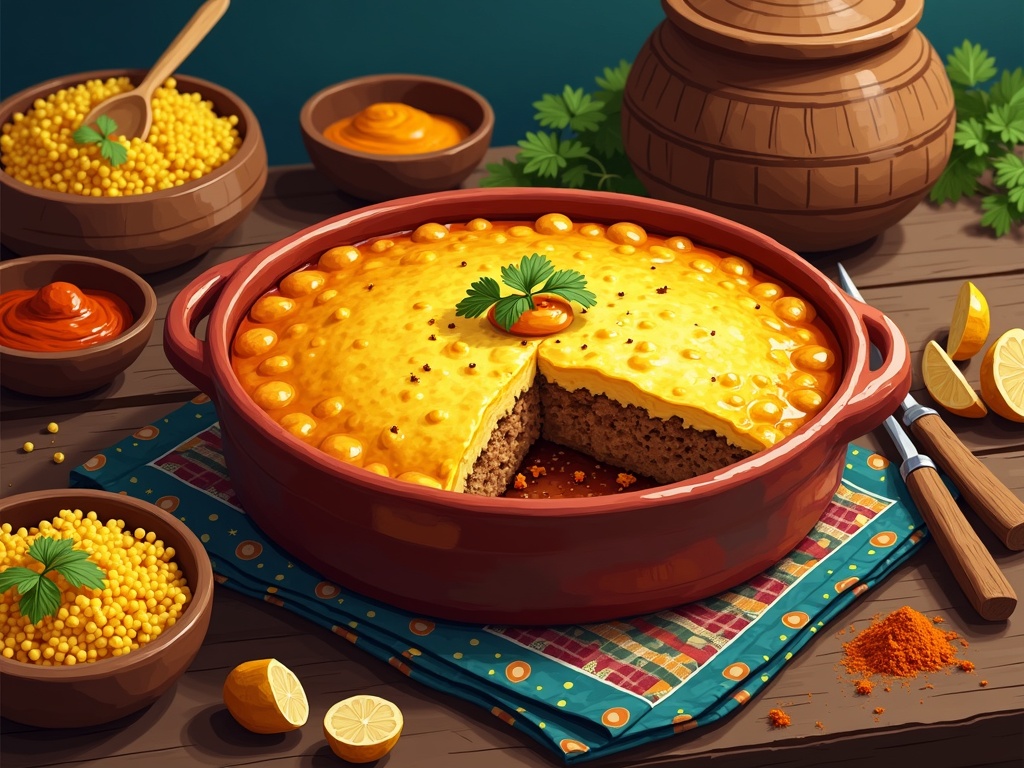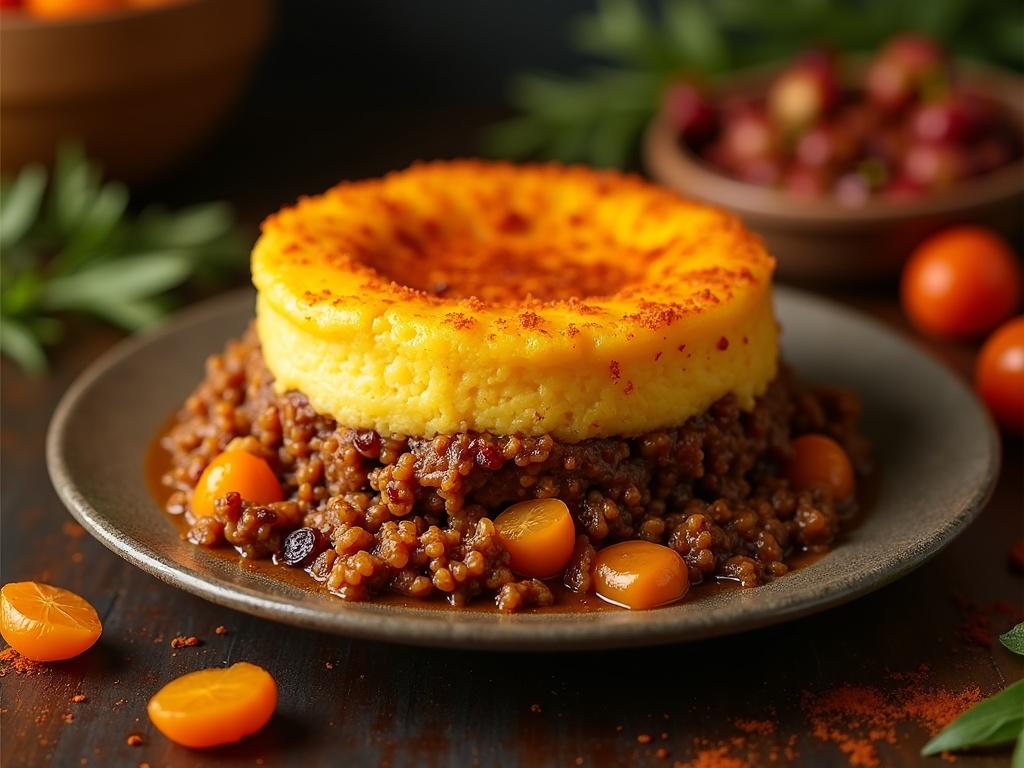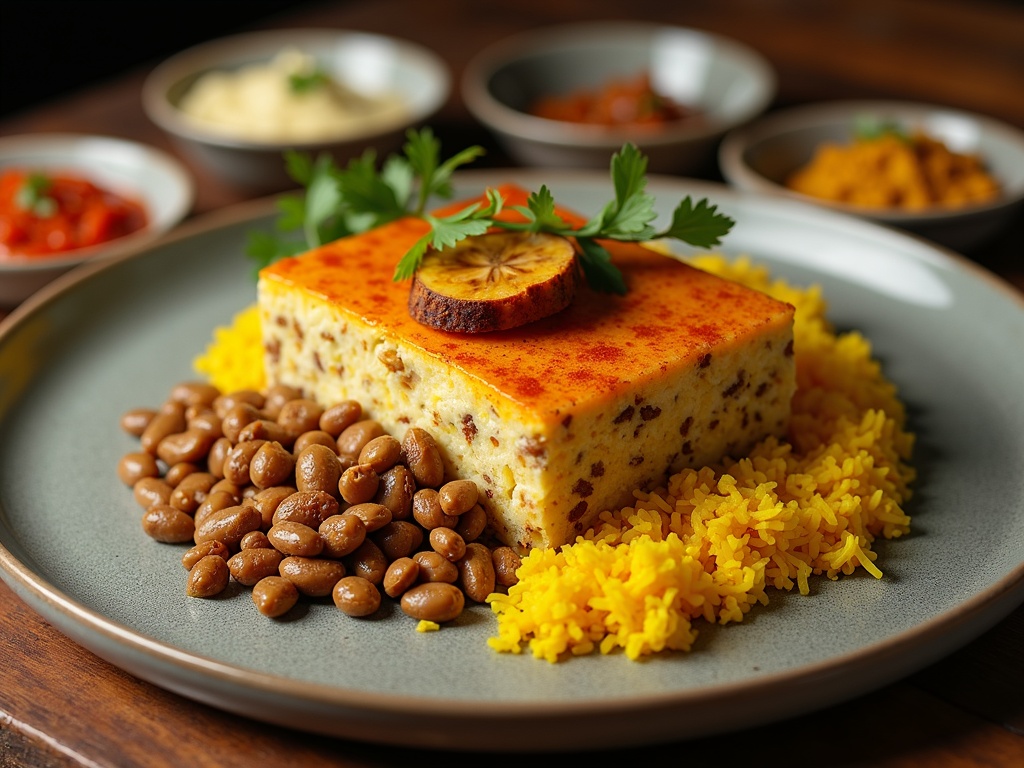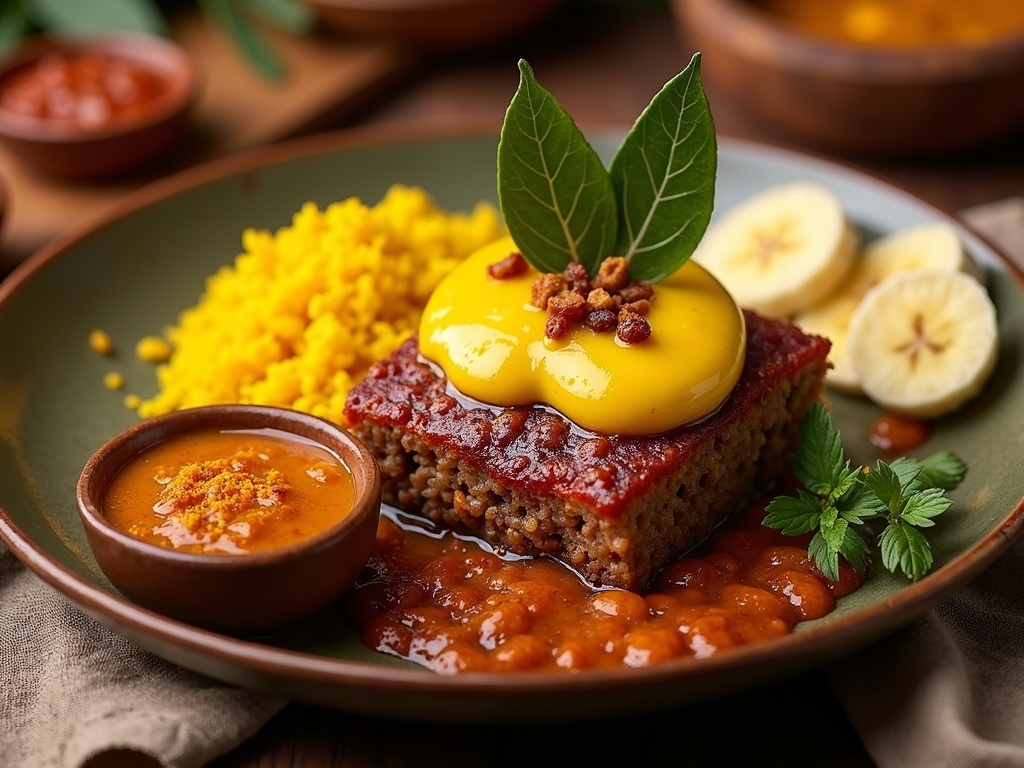Bobotie, South Africa’s national dish, represents a fascinating blend of Indonesian, Cape Malay, and Dutch food traditions dating back over 300 years. This iconic dish features spiced minced meat topped with a savory egg custard, combining aromatic curry spices with sweet dried fruits to create a unique balance of flavors that tells the story of South Africa’s diverse cultural heritage.
Find In This Article
Key Takeaways
- Bobotie originated in the 17th century Cape Colony, with its name derived from the Indonesian word “bobotok” for a similar spiced meat dish.
- Traditional bobotie combines minced meat (typically beef or lamb) with curry spices, dried fruits, and a distinctive egg custard topping.
- The dish reflects South Africa’s multicultural history, incorporating Indonesian spices, Cape Malay cooking techniques, and Dutch influences.
- Bobotie is typically served with yellow rice, sambals, and sliced banana or chutney to enhance its sweet-savory flavor profile.
- Modern versions include vegetarian adaptations using lentils or mushrooms while maintaining the dish’s signature spice blend and custard topping.
A Taste of South African Heritage: The Story Behind Bobotie
Bobotie stands as one of South Africa’s most iconic dishes, with roots stretching back over 300 years into the country’s colonial past. I find the rich history behind this spiced minced meat dish with its distinctive egg custard topping absolutely fascinating – it’s a perfect example of how food tells the story of cultural exchange and adaptation.
The origins of bobotie can be traced to the Cape Colony during the 17th century when the Dutch East India Company established a settlement at what is now Cape Town. The dish’s name itself reveals its multicultural heritage, as it’s derived from the Indonesian word “bobotok,” which referred to a similar spiced meat dish.
Cultural Fusion in a Single Dish
What makes bobotie truly special is how it represents the beautiful fusion of Indonesian, Cape Malay, and South African culinary traditions. This blending occurred through several historical circumstances:
- Indonesian slaves brought to the Cape Colony introduced their cooking techniques and spice combinations
- Cape Malay cooks (descendants of Indonesian and Malaysian slaves) adapted the dish using local ingredients
- Dutch colonists embraced the flavors while adding European cooking methods
- South African elements were incorporated as the dish evolved over centuries
The history of bobotie is inseparably linked to the Indonesian slaves brought to South Africa by Dutch colonizers. These individuals brought their cooking knowledge and spice expertise, which they applied to locally available ingredients. The result was a dish that maintained the aromatic complexity of Indonesian cuisine while adapting to the South African context.
The key components of traditional bobotie reveal this cultural fusion. The base consists of spiced minced meat (typically beef or lamb), often mixed with bread soaked in milk, curry powder, and dried fruits – commonly raisins or sultanas. What makes bobotie distinctively unique is the topping: a savory custard made from eggs and milk that’s baked until golden.
The spice profile of bobotie tells its own story of cultural exchange. Turmeric, cumin, coriander, and bay leaves reflect the Indonesian influence, while the addition of ingredients like apricot jam or chutney speaks to South African adaptations. This harmonious balance of sweet, savory, and spicy flavors creates a dish that’s both comforting and complex.
I’ve found that serving traditions around bobotie further highlight its cultural significance. The dish is typically accompanied by yellow rice (rice cooked with turmeric), various sambals (spicy condiments), and sliced banana or chutney. These accompaniments enhance the flavor balance that makes curry-based dishes so satisfying.
What’s particularly interesting about bobotie is how it evolved from a dish of necessity to a celebrated national treasure. The Indonesian slaves had to work with whatever ingredients were available to them in their new environment while maintaining connections to their culinary heritage. This resourcefulness resulted in a dish that now appears on restaurant menus worldwide as a proud representative of South African cuisine.
Today, bobotie remains a cornerstone of South African home cooking, with countless family recipes passed down through generations. While regional variations exist, the essence remains the same – a heartwarming dish that tells the story of South Africa’s diverse cultural heritage through every flavorful bite.
The enduring popularity of bobotie speaks to both its delicious taste and its ability to represent South African identity. In a single dish, you can taste over three centuries of history – from Indonesian spice islands to the rich meat traditions of South Africa – all coming together in perfect harmony.

How to Make an Authentic Bobotie
Bobotie is a beloved South African dish that combines savory minced meat with sweet dried fruits and a creamy egg topping. The aromatic spices create a complex flavor profile that’s uniquely satisfying. I’ve perfected this recipe over the years and can’t wait to share my method for creating this classic comfort food.
The Base Ingredients
The foundation of any good bobotie starts with quality ingredients properly prepared. For an authentic version, you’ll need:
- 500g minced beef or lamb (or a combination of both)
- 1 finely chopped onion
- 2 cloves of minced garlic
- 2 tablespoons curry powder
- 1 tablespoon chutney (preferably fruit chutney)
- 1 cup of dried fruit (raisins, apricots, or a mix)
- Bay leaves for garnishing
I start by sautéing the onion and garlic until translucent in a bit of oil. This creates a flavorful base that infuses throughout the meat. Then I add the minced meat, breaking it up with a wooden spoon as it browns. The curry powder goes in next, allowing the spices to bloom and release their fragrance before incorporating the chutney and dried fruits.
The addition of dried fruits might seem unusual in a meat dish, but they provide essential sweetness that balances the curry spices. I often mix raisins with chopped dried apricots for varied texture and flavor. Some families have their own traditions around which fruits to include – this is what makes each bobotie recipe unique to the household.
The Creamy Topping and Baking
What makes bobotie truly special is its custard-like topping. To create this:
- Whisk together 2 eggs and 1 cup of milk
- Pour this mixture over the meat after it’s been transferred to a baking dish
- Garnish with bay leaves before baking
This egg-milk mixture transforms during baking into a golden, savory custard that complements the spiced meat perfectly. I bake my bobotie at 350°F (180°C) for about 35-40 minutes, or until the topping is set and has taken on a beautiful golden color.
The bay leaves aren’t just decorative – they infuse a subtle aroma into the custard as it bakes. I’ve found that fresh bay leaves offer better flavor than dried ones if you can find them.
Modern Variations
Traditional bobotie has evolved over time, with many delicious variations now popular:
For vegetarians, the meat can be replaced with lentils or mushrooms while keeping all the signature spices and toppings. Lentils work particularly well as they absorb the flavors and maintain a satisfying texture. I’ve served lentil bobotie to meat-eaters who didn’t miss the meat at all!
The sweetness can be modified by changing up the fruits. Some cooks add grated apple or diced peaches instead of dried fruit. This gives a fresher, lighter flavor that’s especially nice in summer. I sometimes add a tablespoon of apricot jam for extra sweetness when my dried fruits aren’t particularly sweet.
For a more substantial meal, bobotie pairs wonderfully with yellow rice, chutney, and sliced banana. The contrast between the savory spiced egg topping and sweet accompaniments creates a memorable dining experience.
The beauty of bobotie lies in its adaptability. While respecting the traditional elements, don’t be afraid to adjust the spice level or fruit content to suit your taste. The dish should have a balance of savory, sweet, and spicy notes that harmonize rather than compete.
What Makes Bobotie Special
Bobotie stands out as one of South Africa’s most cherished dishes, capturing the essence of the country’s diverse culinary heritage. I’ve found that its distinctiveness comes from several key elements that blend together to create a truly memorable meal.
A Fusion of Flavors and Textures
The heart of bobotie lies in its masterful blend of spices, particularly curry powder that reflects strong Indian influences. This aromatic spice mixture gives the dish its signature warmth and depth, while creating a flavor profile that’s instantly recognizable. What makes this dish truly special is how it balances savory and sweet elements – tender minced meat combines with sweet dried fruits like apricots and raisins to create a delightful contrast that dances on your taste buds.
The custard topping is perhaps the most distinctive feature of an authentic bobotie. Made with eggs and milk, this creamy layer sets on top of the spiced meat mixture during baking, creating a wonderful textural contrast to the hearty base. I’ve noticed that the best bobotie has a perfectly set custard – firm enough to hold its shape when served, yet soft enough to meld with the spiced meat beneath it.
In South African homes, bobotie isn’t just any everyday meal. It’s often reserved for special occasions and family gatherings where it takes center stage. The dish holds particular significance during National Heritage Day celebrations, when South Africans commemorate their cultural roots and traditions through food. As noted in ‘The Cape Malay Cookbook’ by Faldela Williams, bobotie represents the rich cultural tapestry of South African cuisine, particularly the influence of Cape Malay cooking.
For those looking to explore more South African flavors, traditional roast lamb dishes provide another delicious glimpse into the country’s food culture. Similarly, the aromatic spices in bobotie might remind you of a good vegetable curry, though with a uniquely South African twist.
What I love most about bobotie is how it tells the story of South Africa on a plate – the mingling of Dutch, Malaysian, Indonesian, and Indian influences that have shaped the country’s culinary identity over centuries. Each bite offers not just incredible flavor, but a taste of history and culture that makes this dish truly special.

Nutritional Benefits and Health Impact
Bobotie, South Africa’s beloved national dish, packs quite a nutritional punch while satisfying taste buds. I’ve found that a standard serving size of bobotie (approximately 250g) delivers a complete nutritional profile that fits well into many dietary plans.
Macronutrient Breakdown
A typical serving of bobotie contains around 400 calories, making it a moderately calorific main dish. The protein content stands at an impressive 30g per serving, primarily from the minced meat base. This provides about 60% of an average adult’s daily protein needs. Fat content averages 25g, with 20g of carbohydrates and 5g of dietary fiber completing the profile. This balanced macronutrient distribution makes bobotie a surprisingly complete meal on its own.
The dish’s nutritional complexity comes from its varied ingredients. The egg topping adds quality protein and essential nutrients like choline, important for brain health. The dried fruits contribute natural sugars along with antioxidants, while the bread soaked in milk adds calcium and carbohydrates for energy.
Health Benefits of Key Ingredients
The spice blend in bobotie isn’t just flavorful—it’s beneficial for health. Here are some notable benefits:
- Turmeric contains curcumin, a compound with powerful anti-inflammatory properties
- Curry powder blends often include cardamom and coriander, which aid digestion
- Bay leaves can help regulate blood sugar levels
- Ginger offers immune-boosting properties and aids in digestion
I can make several modifications to create a healthier version of this traditional dish. Switching to leaner meat like ostrich or chicken mince reduces fat content significantly. Using whole grain bread instead of white bread increases the fiber content, which improves digestive health.
For those watching their calories, reducing the amount of dried fruit and adding more fresh vegetables like grated carrots or zucchini maintains the moisture while cutting sugar content. These vegetable additions complement the curry flavors beautifully while boosting vitamin and mineral content.
The dish’s balanced profile supports muscle maintenance through its protein content, provides sustained energy from its complex carbohydrates, and delivers a range of micronutrients from its diverse ingredients. Its relatively high fiber content (5g per serving) also supports digestive health and helps maintain satiety.
Modern Interpretations and Serving Suggestions
The classic bobotie recipe has evolved significantly over time, adapting to contemporary dietary preferences while still honoring its rich South African heritage. I’ve seen this beloved dish transform to accommodate various lifestyle choices without sacrificing its distinctive flavor profile.
Contemporary Adaptations for Every Diet
Vegetarian versions of bobotie have gained tremendous popularity in recent years. Instead of the traditional minced meat, plant-based alternatives like lentils, textured vegetable protein, or a mixture of mushrooms and walnuts create a hearty base that absorbs the curry flavors beautifully. These adaptations maintain the dish’s characteristic sweet-savory balance while making it accessible to those avoiding meat.
For those avoiding dairy, the custard topping that defines bobotie can be successfully recreated using plant-based alternatives. Almond milk works exceptionally well as a substitute for cow’s milk in the egg mixture, providing a subtle nutty undertone that complements the curry spices. I’ve found that adding a touch of nutritional yeast to this mixture helps achieve that rich, savory quality traditionally provided by dairy.
When serving bobotie, these accompaniments enhance the experience:
- Yellow rice with raisins and turmeric, the traditional pairing that balances the spicy elements
- Fresh sambals or chutneys, particularly tomato and onion varieties
- Sliced banana, which might seem unusual but provides a cooling counterpoint
- A side of coconut-based condiments for dairy-free options
Bobotie Beyond Borders
While bobotie remains a staple in South African homes and restaurants, regional interpretations showcase fascinating variations. Cape Malay versions typically feature a more pronounced sweet profile with additional dried fruits, while Eastern Cape interpretations might include more aromatic spices reflecting the diverse cultural influences in the region.
The international culinary scene has embraced bobotie, incorporating it into fusion cuisine with creative results. I’ve encountered bobotie-inspired egg curry recipes that blend South African flavors with Indian techniques. Some chefs transform the concept into bobotie spring rolls or empanadas, creating portable versions perfect for appetizers.
High-end restaurants often deconstruct the components, presenting the spiced meat mixture, custard topping, and accompaniments as separate elements on the plate. This modern presentation style highlights the contrast of textures and flavors that make bobotie special.
For those seeking heartier meal options, bobotie pairs wonderfully with roast lamb dishes for special occasions, creating a feast that showcases the diversity of South African cuisine.
The versatility of bobotie extends to breakfast applications too, with some chefs creating morning-friendly versions topped with poached eggs instead of the traditional custard. These adaptations show how this centuries-old recipe continues to evolve while maintaining its cultural significance.
Home cooks often develop their signature versions, adjusting spice levels and sweetness to suit family preferences. Some incorporate vegetable curry elements for added nutrition and complexity, while others streamline the recipe for weeknight convenience.
What makes bobotie truly special is its ability to transform humble ingredients into something extraordinary. Whether served traditionally with yellow rice in a Cape Town home or reimagined as part of a tasting menu in a New York restaurant, bobotie represents the beautiful cultural exchange that shapes global cuisine. Its journey from a colonial-era dish to an internationally recognized comfort food demonstrates how recipes evolve across generations while maintaining their essential character.

Sources:
Traditional Cape Malay Cooking by Faldela Williams
Food, Culture and Society: An International Journal of Culture, Food and Society
Historic Flavor: Bobotie and the Cape Malay People – Culinary Encyclopedia of South Africa

